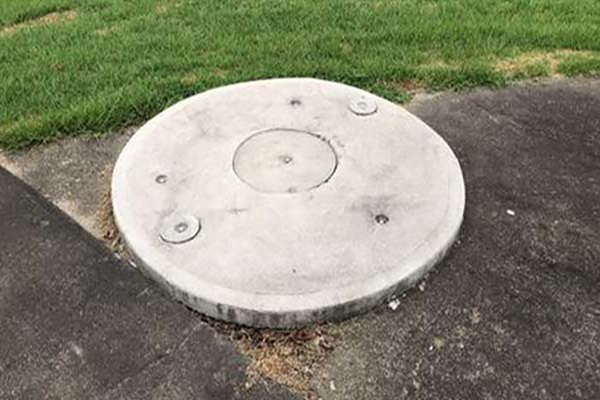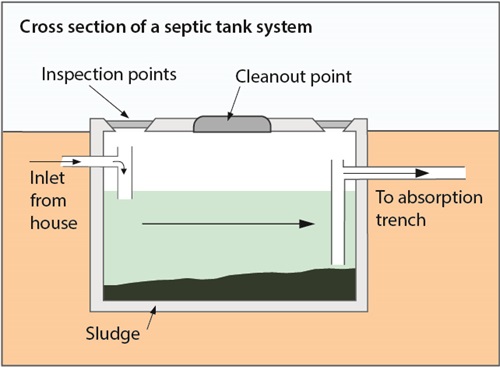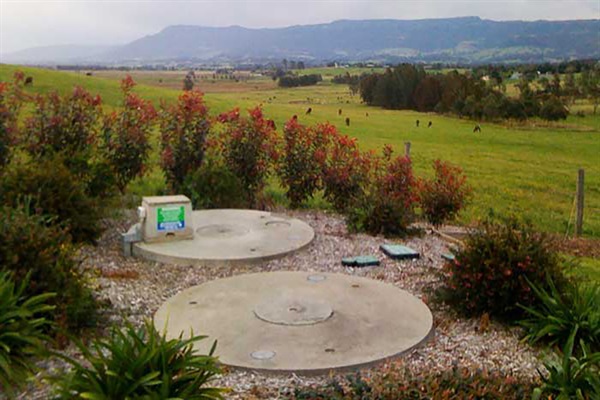Tanks and cleanout services
If your home is not connected to Council’s reticulated town sewer network, then you are likely to dispose of your wastewater using an onsite sewage management system such as a septic tank or aerated wastewater treatment system.
Septic tanks and aerated wastewater treatment systems can last for several years before a cleanout is required but this depends on the care each system receives and whether they are operating efficiently.
Click on any of the tabs below to find out more.
Septic tanks
Septic tanks are generally buried, water-tight containers usually made of concrete, fiberglass, or polyethylene. They are designed to hold wastewater long enough to separate the waste liquids in the tank allowing the solids to settle on the bottom of the tank and any oil and grease products floating on the top.
From the surface, the outside of the tank may look like this:

On the inside, a septic tank will look something like this:

Over time the solids on the bottom of the tank form a sludge that must be removed in order to avoid system failure such as blockages and the transfer of solids to your disposal area like a trench or second collection tank.
The liquid is treated by anerobic bacteria which improves the wastewater quality to ensure it is suitable for subsurface disposal.
Click on the button below to find out how to arrange a septic tank cleanout.
Find out more
Aerated waste treatment systems (ATWS)
An AWTS is most often a concrete tank installed underground so you only see the lid and electrical control box. They can be described as an onsite “mini treatment plant” that treats all the wastewater from your home. This kind of system is designed to treat wastewater to a higher environmental standard than a septic tank.
On the surface, the system may look something like this:

On the inside they look something like this:
An AWTS system must be serviced quarterly by a qualified service agent contracted by you, and they will advise when a cleanout is required.
Due to the delicate nature of the treatment process, the service agent must be onsite at the cleanout to instruct the contractor where to pump from during the cleanout. On completion of the cleanout, the service agent will refill the tank proportionately to avoid the tank from popping out of the ground.
Brands of AWTS include:
- Biocycle
- Bioseptic
- Econocycle
- Envirocycle
- FujiClean
- Garden Master
- Taylex
- Supertreat
- Ultraclear
Click on the button below to find out how to arrange an aerated wastewater tank cleanout.
Find out more
How do I arrange a tank cleanout?
A tank cleanout is a pre-paid service that will be conducted within three (3) working days of us receiving your request.
Depending on the capacity and type of tank on your property, there are different service request forms.
Septic tanks
Click on the button below to find out more
When you get to the form, choose the tab that matches your tank capacity to ensure you submit the correct application form.
Find out more
Aerated wastewater treatment system
When you get to the form, choose the tab that matches your tank capacity to ensure you submit the correct application form.
Find out more
Please note: If your tank is greater than 8,000L or a non-standard tank, you will be invoiced for the service.
How do I arrange an emergency cleanout?
An emergency cleanout is a prepaid service that can be performed within 24 hours of us being notified.
If your tank is at risk of overflowing, submit our online cleanout request form (relevant to your tank size and type) and then call us immediately on (02) 4429 3214 so that we can escalate your request as a high priority.
Please be advised that an emergency cleanout will incur an additional fee payable alongside the standard cleanout fee.
Signs your tank may need a service
There are a few warning signs that signal that there are troubles with your tank.
- Water drains too slowly
- Drainpipes gurgle and make noises
- Strong and persistent sewerage smells
- Water is backing up into the sink
Ensure that these problems are attended to immediately to protect the health of residents and the environment.
Care and maintenance of a system
A good way to care for your tank is to keep the tank lid clear of grass, plants and weeds. If cracks appear in the lid, it is important to get them fixed. Excessive rain may infiltrate the tanks or trenches on the property causing your system to fail.
If carefully operated, systems can last several years before a cleanout is required, but we recommend arranging a cleanout at least every five (5) years.
To get the most value out of your system:
- Every property that has an effluent pump-out system (contained tanks) should be on a scheduled service frequency to maintain the approval to operate the system.
- Trenches to septic tank seep-away systems should ideally be located away from trees and have cleared exposure to direct sun and grass should be cut regularly to promote drying.
- Septic tanks are meant to be full. Some odours may be present and this is not unusual.
- During excessive rain periods, rainwater may infiltrate the tanks or trenches on the property causing the system to fail. Keeping the tank lid clear of grass, plants and weeds is a good way of caring for your tank, if cracks appear in the lid and noticed it is important to get them fixed.
Regardless of type, regular care and maintenance of your system is important.
If you’re experiencing warning symptoms, there are several products on the market that can help maintain a healthy system. Most are enzyme activated products that digest fats, grease and other wastes that can clog the system and cause odours. Usually dosed through the toilet and then flushed, it will significantly increase the time between cleanouts.